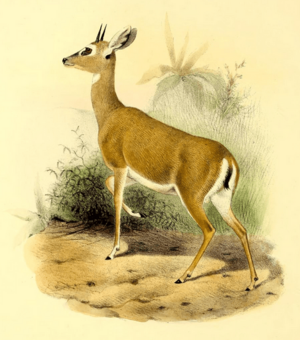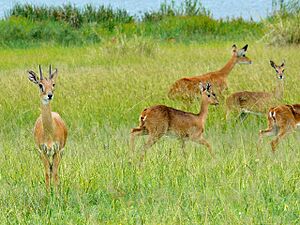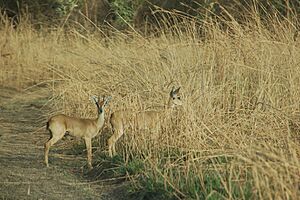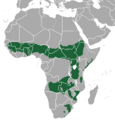Oribi facts for kids
Quick facts for kids Oribi |
|
|---|---|
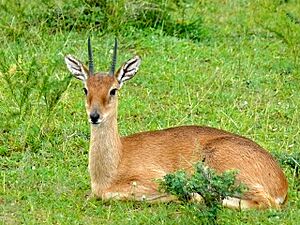 |
|
| Male | |
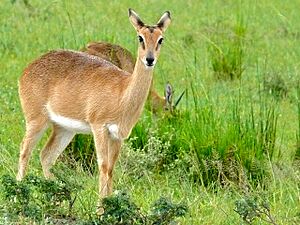 |
|
| Female both at the Murchison Falls National Park, Uganda |
|
| Conservation status | |
| Scientific classification | |
| Subspecies | |
|
See text |
|
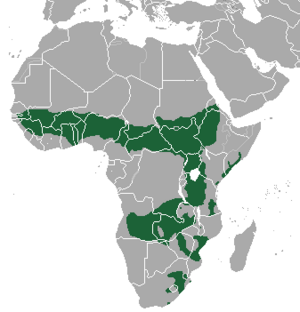 |
|
| Geographic range | |
| Synonyms | |
|
List
Oribia Kirby, 1899
O. aequatoria Heller, 1912 O. grayi (Fitzinger, 1869) O. masakensis Lönnberg and Gyldenstolpe, 1925 O. melanura (Bechstein, 1799) O. pitmani Ruxton, 1926 O. scoparia (Schreber, 1836) O. splendida Schwarz, 1914 |
The oribi (pronounced OR-uh-bee) is a small antelope that lives in parts of eastern, southern, and western Africa. It's the only member of its group, called Ourebia. A German zoologist named Eberhard August Wilhelm von Zimmermann first described it in 1783. There are eight different types, or subspecies, of oribi.
Oribi are about 50–67 centimetres (20–26 in) tall at the shoulder. They weigh between 12–22 kilograms (26–49 lb). They have a slightly raised back, a long neck, and long legs. Their fur is shiny and can be yellowish to reddish-brown. This color stands out against their white chin, throat, belly, and rump (their rear end). Only male oribi have horns. These horns are thin and straight, measuring 8–18 centimetres (3.1–7.1 in) long. They are smooth at the tips and have rings at the bottom.
Oribi are usually active during the day. They often live in small groups of up to four members. Male oribi protect their group's home area, which can be 25–100 hectares (62–247 acres) big. Oribi mostly eat grass, especially fresh grass. Sometimes, they also eat leaves from bushes. The time when they have babies changes depending on where they live. Unlike other small antelopes, oribi can have different ways of mating. A single calf is born after six to seven months. In southern Africa, most babies are born from November to December. Young oribi stop drinking their mother's milk at four to five months old.
Oribi live in many different places. These include savannahs, floodplains, and tropical grasslands with tall grasses. They can also be found in montane grasslands (grasslands in mountains) at lower heights, up to 2,000 metres (6,600 ft) above sea level. You can find oribi from Senegal in the west to Ethiopia and Eritrea in the east. They also live south to Angola and the Eastern Cape in South Africa. The number of oribi has gone down. This is because their habitats are being used for farming, and they compete with farm animals for food. The IUCN (a group that tracks animal populations) lists the oribi as an animal of Least Concern.
Contents
About the Oribi
The scientific name for the oribi is Ourebia ourebi. It belongs to the Bovidae family, which includes animals like cows, goats, and other antelopes. The German zoologist Eberhard August Wilhelm von Zimmermann first described this species in 1782. The name "oribi" comes from the Afrikaans word oorbietjie.
Scientists have studied the family tree of antelopes. They found that the oribi is a unique group compared to other antelopes.
There are eight different types, or subspecies, of oribi:
- O. o. dorcas
- O. o. gallarum
- O. o. haggardi – This type lives in eastern Africa. It is listed as Vulnerable by the IUCN, meaning its numbers are decreasing.
- O. o. hastata – This type lives from Kenya south to Mozambique and east to Angola.
- † O. o. kenyae – This type used to live on the lower slopes of Mount Kenya, but it is now extinct.
- O. o. montana – This type lives from northern Nigeria east to Ethiopia and south to Uganda.
- O. o. ourebi – This type lives south of the Zambezi River.
- O. o. quadriscopa – This type lives in western Africa.
- O. o. rutila
Some zoologists, like Colin Groves and Peter Grubb, think that some of these subspecies, such as O. o. hastata, O. o. montana, O. o. ourebi, and O. o. quadriscopa, should be considered their own separate species.
Appearance
The oribi is a small and slim antelope. It stands about 50–67 centimetres (20–26 in) tall at the shoulder. Its body, from head to tail, is usually between 92 and 110 centimetres (36 and 43 in) long. Oribi weigh between 12–22 kilograms (26–49 lb).
Males and females look a bit different in size (this is called sexual dimorphism). Males are usually a little smaller than females. However, in the O. o. ourebi subspecies, females are smaller. The oribi has a back that is slightly raised, a long neck, and long legs. Its fur is shiny and ranges from yellowish to reddish-brown. Its chin, throat, belly, and rump are white, which creates a nice contrast. The tail is bushy and brown to black on the outside, with white on the inside. One type, O. o. hastata, has a tail that is completely black. The color of the fur can vary a bit between different subspecies. For example, O. o. ourebi is a rich reddish-brown, while O. o. hastata is more yellow.
Only male oribi have horns. These horns are thin and straight. They are 8–18 centimetres (3.1–7.1 in) long. The tips are smooth, and the bases have rings. The longest horn ever recorded was 19.1 centimetres (7.5 in) in Malawi in 1998. Oribi have at least six different, well-developed scent glands. These include noticeable glands near their eyes. Their bodies are built to hold these many glands. Female oribi have four teats for feeding their young.
Behavior and Daily Life
Oribi are mostly diurnal, meaning they are active during the day. However, they might also be active at night sometimes. They rest in hidden spots when it rains. Unlike other small antelopes, oribi can have different ways of mating, depending on their habitat. Sometimes, one male mates with several females (polygyny). This often happens when there are more females than males. Studies suggest that polygyny can be helpful in areas with many predators. This is because it leads to groups forming, which helps protect them from danger. Small groups of up to four oribi are common.
Male oribi protect their group's home area, which can be 25–100 hectares (62–247 acres) in size. Female group members might also act aggressively to chase away other animals that enter their territory. One study found that the number of females visiting a male's territory depends on how good his horns look, especially if they are symmetrical. Males mark plants and soil in their territories using scent from glands near their eyes and with their droppings. They mark more often when there are many other male oribi nearby. Stronger males tend to have more access to females in and around their territory. An interesting part of oribi social behavior is the "dung ceremony." In this ceremony, all the animals temporarily gather their droppings in one spot. Oribi that are at least three months old have been seen making one to three alarm whistles when they sense danger. Adults whistle more than young oribi, and males seem to whistle more often. Common predators of oribi include meat-eating animals like jackals.
What Oribi Eat
Oribi mostly eat grass, which makes them grazers. They prefer fresh grasses but will also eat leaves from bushes sometimes. Grass can make up to 90% of their diet. They like specific types of grasses, including Andropogon, Eulalia, Hyparrhenia, Loudetia, Pennisetum, and Themeda species. Oribi also regularly visit mineral licks to get important nutrients. They have been seen eating flowers and Boletus mushrooms. Oribi groups gather more often during the rainy season when there is plenty of grass.
Reproduction and Life Cycle
A female oribi is pregnant for six to seven months. After this time, she gives birth to a single calf. In southern Africa, most births happen from November to December. The newborn calf stays hidden for about a month. The mother visits her calf regularly to feed it milk for about half an hour. Male oribi might guard their young from predators and keep other males away. Young oribi stop drinking their mother's milk when they are four to five months old. Oribi usually live for 8 to 12 years in the wild. In zoos or protected areas, they can live for 12 to 14 years.
Where Oribi Live
Oribi live in many different places. These include savannahs, floodplains, and tropical grasslands where grasses are 10–100 centimetres (3.9–39.4 in) tall. They also live in montane grasslands (grasslands in mountains) at lower heights, up to 2,000 metres (6,600 ft) above sea level. Oribi are often attracted to areas that have recently been burned. They choose their habitat based on how much cover is available to hide from predators.
The number of oribi in an area usually ranges from 2 to 10 animals per square kilometer. However, in tropical grasslands that get a lot of rain (over 110 centimetres (43 in) annually) and open floodplains, there can be as many as 45 oribi per square kilometer. Oribi often live in the same areas as larger grazing animals. These include the African buffalo, hippopotamus, hartebeest, Thomson's gazelle, and topi. When these different species live close together, it helps them all stay alert for predators.
Oribi are found in specific areas across eastern, southern, and western Africa. Their range stretches from Nigeria and Senegal in the west to Ethiopia and Eritrea in the east. They also live south to Angola and the Eastern Cape in South Africa. Sadly, it is thought that they might be extinct in Burundi.
Threats and Protection
The IUCN has classified the oribi as an animal of Least Concern. This means they are not currently in danger of disappearing. In 2008, the total number of oribi was estimated to be around 750,000. However, one type, O. o. haggardi, is listed as Vulnerable. This is because, as of 2008, there were fewer than 10,000 adult animals of this type, and their numbers are still going down.
Hunting is not a major threat to oribi, as they can tolerate some hunting. However, in Comoé National Park in Côte d'Ivoire, the oribi population dropped by a huge 92%. This was due to illegal hunting, also known as poaching. The number of oribi has also decreased because their habitats are being turned into farmland. They also have to compete with farm animals for food.
Oribi live in many protected areas across their range. Some of these parks include:
- Gashaka Gumti National Park in Nigeria
- Pendjari and W National Parks in Benin
- Aouk Hunting Zone in Chad
- Benoue, Bouba Njida, and Faro National Parks in Cameroon
- Manovo-Gounda St. Floris National Park in the Central African Republic
- Garamba, Upemba, and Kundelungu National Parks in the Congo-Kinshasa
- Omo National Park in Ethiopia
- Masai Mara Game Reserve and Ruma National Park in Kenya
- Golden Gate Highlands National Park in South Africa
- Serengeti National Park in Tanzania
- Kidepo Valley, Lake Mburo, and Murchison Falls National Parks in Uganda
- Kafue and Liuwa Plain National Parks and Bangweulu Swamp in Zambia
Images for kids



